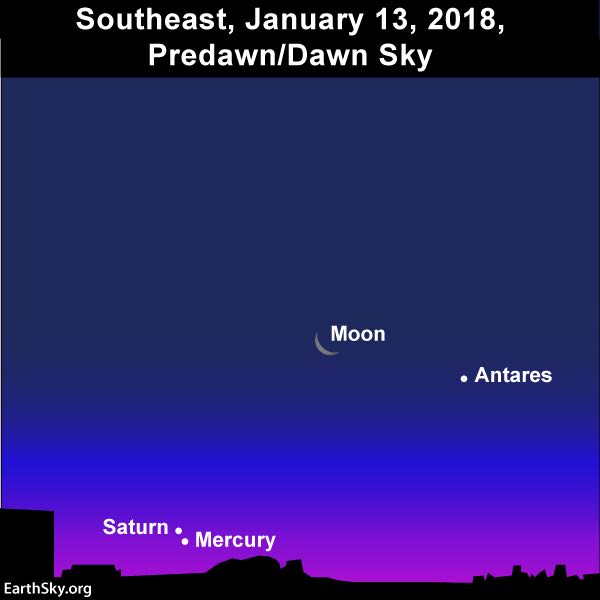
On November 28, 2017, the innermost planet Mercury will swing 3o south of the 6th planet, Saturn, on our sky’s dome. Astronomers call this event – when two planets lie north and south of one another on the sky’s dome – a conjunction. The conjunction of Mercury and Saturn on November 28 is the first in a series of three Mercury-Saturn conjunctions … that is, the first part of what astronomers call a triple conjunction. More about that below.
First, here’s the view on November 28. Mercury and Saturn are both low in the west after sunset. Find an unobstructed horizon in the direction of sunset, and, if possible, perch yourself on a hill or balcony. Then look for Mercury and Saturn low in the western sky, near the sunset point on the horizon, as soon as the sky begins to darken.
Mercury is the brighter of these two starlike objects, shining almost twice as brightly as Saturn. So if you only see one point of light, it’s probably Mercury. Three degrees of sky approximates the width of your thumb at an arm’s length from your eye. On and around November 28, both of these worlds will fit inside the same binocular field of view.
The Southern Hemisphere has the advantage over the Northern Hemisphere for seeing Mercury and Saturn. South of the equator, these two worlds stay out for one and one-half hours (or more) after sunset. At mid-northern latitudes, the twosome doesn’t stay out for a lot longer than one hour after the sun.
Click here for recommended almanacs; they can help you find out the setting times for Mercury and Saturn in your sky
From the Northern Hemisphere, Mercury sets first and then Saturn sets afterwards. South of the equator, Saturn sets first and then Mercury plunges beneath the horizon. As one might expect, Mercury and Saturn set at nearly the same time at the equator.
The conjunction of Mercury and Saturn on November 28 is the first in a series of three Mercury-Saturn conjunctions. The term triple conjunction is used whenever two planets, or a planet and a star, appear due north-south of each other in the sky three different times in a relatively short space of a few months. That’s what’s happening here.
The second conjunction occurs on December 6, 2017, when Mercury swings less than 1.5o south of Saturn. But this conjunction will be very hard to catch because – by that time – both Mercury and Saturn will be buried deeply in in the glare of sunset.
The third conjunction of this triple conjunction will the closest of them all, with Mercury sweeping about 0.7o south of Saturn on January 13, 2018. (Seven-tenths of one degree on the sky’s dome is approximately equal to the width of your little finger at an arm’s length.) This conjunction on January 13, 2018, which occurs in the morning sky, should be fairly easy to view – especially since the lit side of the waning crescent moon will be pointing right at Mercury and Saturn.

In the meantime, though, see if you can catch the evening conjunction of Mercury and Saturn after sunset on November 28, 2017.











